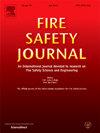过电流铜线上起泡痕迹的形成机理和微观结构分析
IF 3.4
3区 工程技术
Q2 ENGINEERING, CIVIL
引用次数: 0
摘要
电气火灾经常造成严重的人员伤亡,而过流故障是主要原因。本研究调查了聚氯乙烯(PVC)绝缘铜线上起泡痕迹的形成机制,传统上认为这是由于直接暴露在火焰中造成的。我们对承受 190 至 240A 过电流的聚氯乙烯铜线进行了全面分析,研究了由此产生的微观结构变化。我们的研究结果挑战了传统观念,证明某些起泡痕迹,尤其是非阻燃聚氯乙烯(NF-PVC)绝缘电线上的起泡痕迹,是过流故障而非火焰暴露造成的。通过将详细的微观结构分析与聚氯乙烯绝缘层的热分解特性相结合,本研究为诊断电气火灾的原因提供了新的见解,并倡导在火灾调查中采用更细致的方法。本文章由计算机程序翻译,如有差异,请以英文原文为准。
Formation mechanism and microstructural analysis of blistering marks on overcurrent copper wires
Electrical fires frequently result in severe casualties, with overcurrent faults being a primary cause. This study investigates the formation mechanisms of blistering marks on polyvinyl chloride (PVC) insulated copper wires, traditionally attributed to direct flame exposure. We conducted a comprehensive analysis of PVC copper wires subjected to overcurrents ranging from 190 to 240A, examining the resultant microstructural changes. Our findings challenge conventional beliefs by demonstrating that certain blistering marks, especially on non-flame-retardant PVC (NF-PVC) insulated wires, are indicative of overcurrent faults rather than flame exposure. By integrating detailed microstructural analysis with the thermal decomposition characteristics of the PVC insulation, this study provides new insights into diagnosing the causes of electrical fires and advocates for more meticulous methods in fire investigations.
求助全文
通过发布文献求助,成功后即可免费获取论文全文。
去求助
来源期刊

Fire Safety Journal
工程技术-材料科学:综合
CiteScore
5.70
自引率
9.70%
发文量
153
审稿时长
60 days
期刊介绍:
Fire Safety Journal is the leading publication dealing with all aspects of fire safety engineering. Its scope is purposefully wide, as it is deemed important to encourage papers from all sources within this multidisciplinary subject, thus providing a forum for its further development as a distinct engineering discipline. This is an essential step towards gaining a status equal to that enjoyed by the other engineering disciplines.
 求助内容:
求助内容: 应助结果提醒方式:
应助结果提醒方式:


